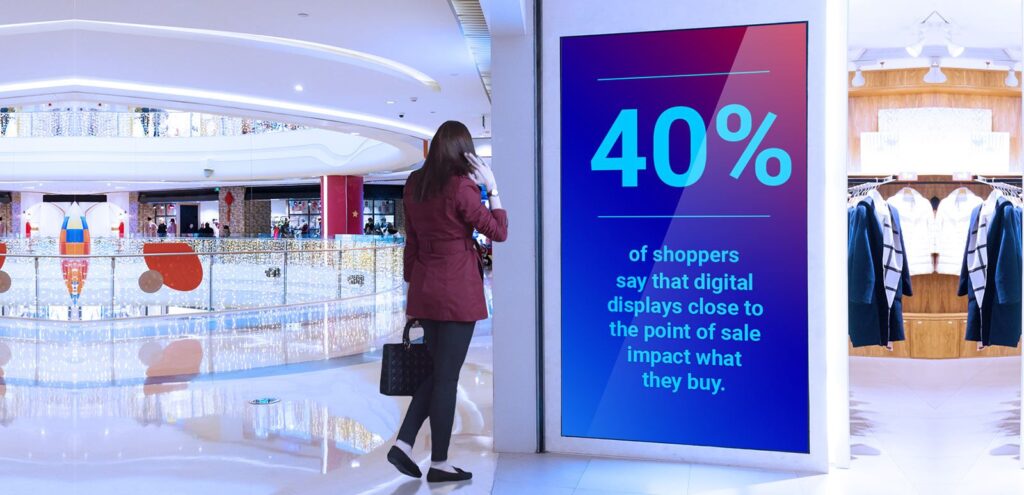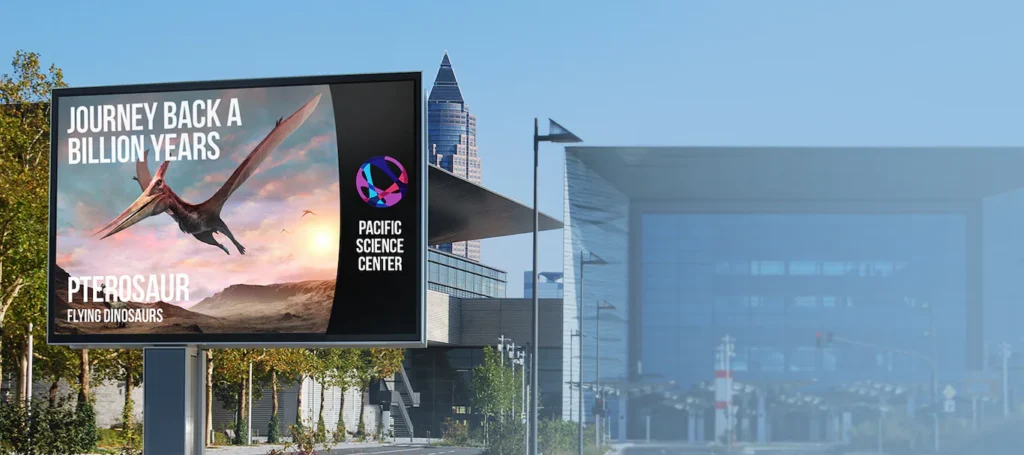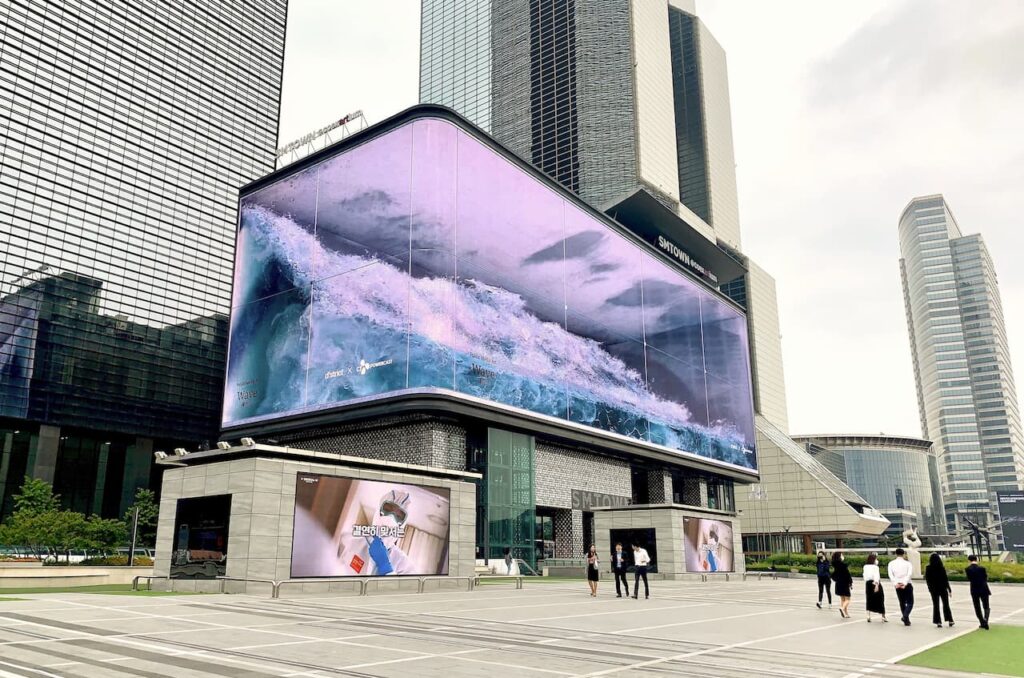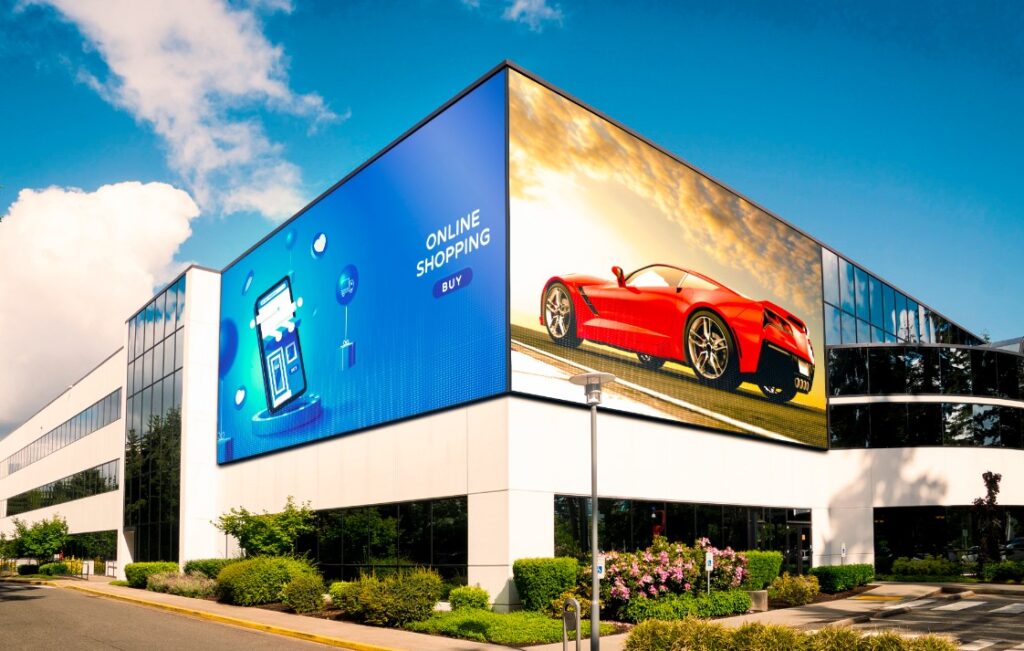Are you planning to buy or rent digital signage for your retail store? Want to attract more people’s interest in your advertisement or new product? Commercial LED display, LCD, projector, TV? How to select the most suitable one? Read this post to get all the answers!
In the advertising display field, a variety of display devices compete fiercely. How do you choose the best screen for your project? This article takes you through the differences between several common display devices and how to realize the value of an OOH display screen.
What is Commercial LED Display?
It is usually used to play corporate or brand promotional videos or production information. There are many types of digital display screens: indoor video walls, outdoor screens, poster LED displays, etc.
It is not difficult to find billboards on the walls of buildings next to the streets, large shopping malls, hotels, stations, retail stores, and airports. LED video walls with high-definition picture quality, screens of various sizes, and high-cost performance become the new favorite of brand promotion.
What Can LED Display Bring to Advertising?

Source: fireflyled.com
Changeable Advertisement Contents
LED displays can display various types of content: video, image, text, or other formats. At the same time, it is not difficult to change the displayed content according to different delivery requirements.
Compared with posters or lightboxes, dynamic digital signage is more eye-catching to attract people’s attention.
Adjustable Screen Size
From a dozen square meters to hundreds of square meters, the led display screen can be of any size. It is mainly due to the characteristics of its modular design.
From small displays in retail stores to oversized outdoor video walls on building facades, screens of different sizes provide excellent visual effects.
It means that advertising screens have quite a wide range of application scenarios. Of course, depending on visual habits, it is easier for people to focus on larger and more prominent objects.
Excellent visual Performance
LEDs have luminous properties. The high brightness of the outdoor display allows people to see the content even under sunlight. At night, the display screen is an excellent media as people can see it clearly.
Billboards of various shapes become beautiful landscapes in the city at night.
4 Reasons to Invest in Display Screens in Shopping Malls

Source: broadsign.com
In the application of new commercial displays, LED video wall stands out among many display devices with many advantages such as high-definition display, high reliability, and flexible shapes. As long as you observe carefully, you will find that they are already everywhere in the mall. It can be seen that they have become the darling of retail stores. High-tech led screen contributes to trendy business marketing!
As one of the main places for public entertainment, large shopping malls are also the first choice for commercial display. The dense and mobile flow of people attracts merchants to place advertisements in shopping malls to promote products or brands.
Among them, the form of advertising on LED displays is the most popular. Today, we will take you to understand the advantages and functions of setting up display screens in shopping malls.
1. Convenient and fast transmission of information
Visual display of information is the biggest function of LED displays. Compared with posters, banners, and other forms, it uses more flexible means to exclusively promote information such as promotional activities, new products on the market, and brand discounts.
The dynamic form of publicity helps to break the status quo of stereotyped publicity and form a unique new scene.
2. Strong visual impact

Source: samsung.com
The dynamic, sound-picture-integrated LED display screen touches the audience’s senses in all directions. Brightly colored pictures, dynamic music, and smooth videos can stimulate consumption impulses.
3. Improve store image
In addition to advertising, the high-definition large screen also plays a decorative role to enhance the image of the store. High-end stores make consumers more willing to visit the store. In special festivals, the LED wall plays special festival songs and festival blessing videos, which can create a good festival environment and enhance the atmosphere.
4. Various shapes
Besides common indoor/outdoor fixed LED screens, creative LED displays and window transparent led boards are popular in shopping malls.
Creative shapes such as waves, cylinders, streamers, and magic cubes inject new vitality into the new commercial display.
What is LCD Display?
LCD means liquid crystal display. It does not emit light directly. Liquid crystal displays use a liquid crystal solution of two sheets of polarized material. When the current passes through the liquid, the crystals will re-arrange to achieve the purpose of imaging.
The brightness of the LCD is lower, so it is usually used in the indoor environment. For example, at the entrance of the shopping mall or next to the elevator, the screen can display the distribution diagram of the shopping mall or some merchant promotion information.
Advantages and disadvantages of it

Source: lookdigitalsignage.com
Advantages
- The size is controllable, and the appropriate size can be selected according to the project requirements
- The display effect is good, the color is bright, and the picture quality is high-definition
- Splicing large screen supports multi-screen display. Suitable for surveillance systems and office scenarios
- Low power consumption and long service life.
Disadvantages
- The integrity of the picture is affected by patchwork. Although the patchwork has been reduced, there are still black edges
- Due to the influence of brightness and waterproof performance, it is not suitable for outdoor scenes.
Projector or TV?
Projectors are suitable for exhibition reports or performances and lectures. It can also project pictures in small conference rooms and it is the office display device of many companies.
The brightness of office projectors should be higher than the household projector, which is to meet the needs of people to read notes or data. In general, factors such as background, brightness, and space size of the venue need to be considered when choosing a suitable projector.
TVs are mostly used in small retail stores such as milk tea shops and coffee shops. They can display menu prices, and new product information, play branding videos, drink posters, and more. The dynamic vision of the large screen makes the store’s publicity more deeply rooted in the hearts of the people.
It can be seen that different display devices have different characteristics. It is these characteristics that determine their usefulness.
Difference

Source: media4growth.com
As the led panel expert from Unit LED says, the difference between a LED screen and an LCD Display is reflected in the following aspects:
- Brightness ─ The brightness of the outdoor led screen is 5500-6500 cd/m2 (Nits). The liquid crystal display is mostly used indoors.
- Stitching gap ─ The LED video wall has a complete picture and realizes seamless splicing. The splicing black border of the large liquid crystal displays is more obvious.
- Viewing angle ─ The LED wall has a wider viewing angle than it.
- Resolution ─ LCD has a higher resolution than led display. Before the birth of small-pitch LED displays, it was the mainstream display terminal product for digital signage.
- Application ─ The application scope of advertising LED screens is wider. Such as indoor and outdoor advertising, business meetings, stadiums, 3D billboards, etc. Liquid crystal displays are mainly used in computers or televisions.
The commercial display screen is mostly used to publish information and product advertisements in public places.
According to the requirements of display products in indoor and outdoor environments, LCD is used in the field of indoor advertising due to its high resolution and delicate colors. Outdoor advertising displays need to have high brightness, high protection ability, and good durability.
Outdoor advertising screen is a huge market. In addition to indoor advertising and TV advertising, the market share of outdoor advertising is constantly increasing.
Billboards and digital advertising are growing yearly, while radio, television, and print advertising markets are shrinking. It can be seen that the potential of OOH display screens is huge.
It is this good market prospect that many manufacturers are using the functions of digital billboards in creative ways.
For example, the outdoor naked-eye 3D billboard created by combining the led display screen with naked-eye 3D has set off a wave of enthusiasm on social media.
In general, which display to choose needs to be determined according to the details of your project. Which screen is best? This is a question that cannot be answered without detailed requirements. What kind of screen should be used will be defined by project details and what is expected to be achieved.
Conclusion
Which one can win in the field of digital signage? In the field of indoor/outdoor advertising, a variety of display devices have their characteristics. After reading this article, LED or LCD, Projector or TV? Do you have an answer?















